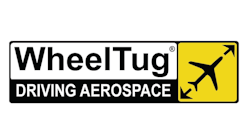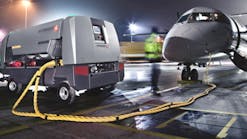Attendees of the Paris Air Show tend to look skyward to take in new aircraft showing off their best moves while in the air.
But at the 2013 show, eyes were cast decidedly downward as attendees caught a demonstration of an A320 moving backward and making sharp turns on the tarmac at Le Bourget Airport. All with the jet’s engine switched off. And without a tug in sight.
The A320 used electric motors developed by Honeywell and Safran SA attached to both sides of the plane’s main landing gear and powered only by the APU.
“The system would, therefore, reduce, if not remove altogether, the need for aircraft ground equipment to maneuver aircraft in and out of stands,” according to a press release.
The joint venture’s product could save up to $200,000 per aircraft per year in fuel costs, according to the companies.
The aircraft, however, showed off just the latest system designed to save jet fuel, cut carbon emissions and save time while aircraft are at their least efficient place – on the ground making the turn at the gate and taxiing to takeoff.
The Honeywell-Safran joint venture has company with at least one other competitor working toward similar ends for a greener ramp. WheelTug, another exhibitor at last June’s air show, has gained the most traction among potential customers with its system that fits into the nose landing gear.
At the show, WheelTug announced yet another agreement with Icelandair. With the new reservations on its order books, the company has deals with 11 airlines from Europe, America, the Middle East and the East Asia.
The two systems bare some similarities:
- Both systems are geared toward narrow-body aircraft that typically fly frequent short-haul flights and spend an inordinate amount of time on the ground.
- Both systems are essentially an electric motor run by the APU, which is at the same time a simple idea, but an incredibly difficult process to integrate into the aircraft.
- Both systems provide full mobility to the plane while it’s on the ground without the use of the aircraft's jet engines or tugs for pushback and taxi operations.
- Both systems add weight to the aircraft, which makes the approval process for the equipment that much more difficult. Both companies say that the cost savings would more than justify the added pounds.
But from those basic similarities, each system splits between the merits of either pulling the plane with motors in the nose landing gear or pushing it with motors in the main landing gear.
PULLING
WheelTug’s electric motors power the nose gear in a package that fits into the existing wheel well space that’s 5 inches wide and weighs 300 pounds. By outfitting the nose landing gear, the company says that reduces the weight of such a taxiing system and makes approval of the system less complicated since the noise landing gear does not affect the aircraft’s braking system.
“We’re turning the airplane into a hybrid,” company CEO Isaiah Cox said over the summer on CNBC.
The company says the electric unit needs only 4 pounds of fuel per minute by using the APU, representing an 80 percent reduction in ground operation fuel consumption.
“It’s like packing an elephant into the nose wheel,” Cox told us.
The company’s business plan is to install its electric system into existing aircraft, something Cox says can be installed overnight.
To persuade airlines to make the modification, Cox offers his product on very generous leasing terms – as low as “free” with WheelTug sharing in the cost savings.
“Airlines can enjoy cost-savings from Day One,” Cox says, “with no capital expenditures.”
WheelTug’s sales literature offers a generous range of cost-savings with its system that ranges from $785,000 to $2.5 million per plane per year.
Right off the bat, the WheelTug system would eliminate the cost of pushback, which Cox says ranges from $50 to $150, and the consumption of about 55 gallons of fuel spent while taxiing before and after takeoff, based on average burn rates and ground times at U.S. airports.
Cox shared other cost-savings that naturally come to mind, such as fuel savings, FOD cost avoidance, taxi-in/taxi-out time savings and pushback savings.
More “aggressive airlines,” Cox says, can further take advantage of engine-off operation by boarding/deboarding passenger from the rear door and through the front door.
Also, airports under morning noise curfew restrictions could create more lucrative slots.
“This can add 5-10 additional daily morning take-off slots per runway,” Cox says. “First-morning flights are the most valuable for business travelers.”
Cox expects certification of its design sometime in the first half of 2014. Six airlines, including KLM, Alitalia and El Al, have agreements to install the system on more than 285 aircraft at some point in the second quarter of 2014.
PUSHING
Safran and Honeywell, on the other hand, have developed an electric unit that attaches to the main landing gear.
Dubbed the “Electric Green Taxiing System,” the wheel on each main landing gear is equipped with an electric motor, reduction gearbox and clutch assembly to drive the aircraft, while unique power electronics and system controllers give pilots total control of the aircraft’s speed and direction during taxi operations.
Each unit of the Honeywell system, including the motor, gearbox and clutch weighs about 220 pounds.
“EGTS will be for aviation what hybrid cars were for the automotive industry,” says Brian Wenig, EGTS program vice president, Honeywell Aerospace. “The potential of fuel savings and emissions reductions that can be had with the system will be monumental for airlines.”
According to the joint venture, a short- or medium-range aircraft spends up to 2.5 hours of its time on taxiways every day. As a result, the EGTS could save approximately 600 kilograms of fuel used during taxiing from being consumed daily, according to Honeywell and Safran estimates.
Based on standard taxiing procedures for a narrow-body aircraft, the company says the system will save up to 4 percent in block fuel costs and reduce carbon emissions by 75 percent, a particularly important issue at European airports due to EU carbon taxes.
The main advantage of placing the system in the main landing gear is traction. The companies say less than 10 percent of an aircraft’s weight is on the nose gear, which makes the landing gear a better place to handle adverse conditions on the ground. (For its part, WheelTug says it has tested its system in less than optimal weather conditions and seen no problem.)
Since the system is situated in the landing gear and represents a structural change to the airframe, the company primarily takes an OEM approach to marketing the system, although it says retrofits are a possibility.
According to a Wall Street Journal report published last June, the joint venture has already invested about $250 million into the concept and built 15 systems that have been put through 3,000 hours of testing.
During the air show last June, the joint venture announced an extended collaboration on the development of the EGTS with AirFrance.
“At Air France,” said Bruno Delile, senior vice president, new aircraft and corporate fleet planning for the airline, “we are particularly conscious about energy efficiency. With the electric green taxiing system, we aim to reduce our fleet’s carbon footprint at airports, while also decreasing noise and useless fuel consumption.”
The joint venture, however, figures it needs to spend at least several times that amount to persuade Boeing Co. or Airbus to install the system on new narrow-body aircraft.
The joint venture’s system is due to be commercially available by 2016.







